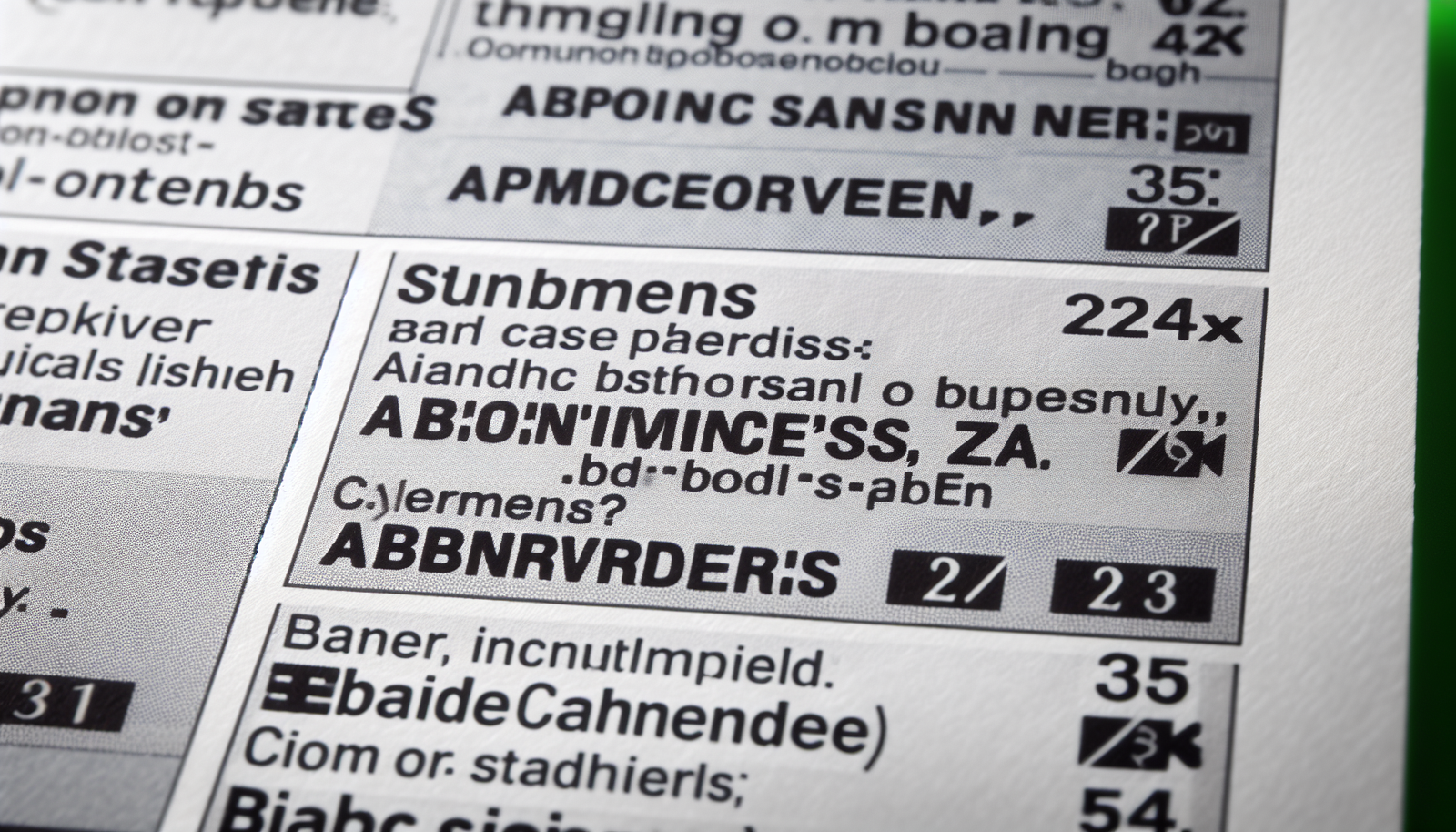
Unravel the intricate world of bank statement abbreviations with this enlightening article prepared just for you. Think of it as embarking on a journey through the labyrinth of acronyms found on your monthly financial summary, your bank statement, which usually baffles your mind. Glamorously untangling, one abbreviation at a time, this piece offers you an enlightening expedition in cracking financial jargon. Your guide through this often cryptic landscape of bank statement abbreviations, it beckons you to embrace a deeper understanding, empowering you to take charge of your financial literacy.

Understanding Bank Statement Abbreviations
Cracking the enigmatic cryptogram that is your bank statement can feel akin to translating hieroglyphics in an ancient, sand-dusted tomb. Indeed, the matrix of letters and numbers that greet you is often cluttered with mysterious abbreviations that may seem like jumbled gibberish at first glance. Unraveling this coded language, however, holds the key to your financial story, portraying a vivid narrative of your economic activities.
Purpose of bank statement abbreviations
The lingua franca of the banking world, these abbreviations are used to economize on space and clarify communications. Bank statement abbreviations are essentially a sort of shorthand – cryptic to the uninitiated, but efficient and enlightening for those who speak the language. They give you a summarized view of the various transactions processed in your account, serving as signposts in the winding trail of your financial journey.
Challenges with deciphering bank statement abbreviations
Despite their many perks, bank statement abbreviations are often as perplexing as a page from a complex codebook. The problem is enhanced by the lack of a universal banking language. Different banks have distinct vernacular, adding an additional layer of complexity to an already challenging feat.
Importance of understanding bank statement abbreviations
The ability to interpret these abbreviations is not just a fun party trick but an important life skill. It allows you to monitor your account activity accurately, ensuring you are informed about every transaction. It helps to reveal hidden or forgotten charges, detect anomalies, and provide an invaluable paper trail for future reference.
Common Bank Statement Abbreviations
To illuminate this cryptic labyrinth, let’s delve into some of the most typical abbreviations you’re likely to encounter on bank statements.
ATM: Automated Teller Machine
Perhaps one of the most recognizable abbreviations, ATM, refers to transactions made at an Automated Teller Machine, your friendly neighborhood dispensary of cash.
CHK: Check
CHK is the underappreciated old-fashioned way of transferring money. It stands for Check, indicating payments made or received via this paper-based method.
D/D: Direct Deposit
D/D is an electronic transfer of your salary or other incomes directly into your bank account, all without the physical constraints of cash or check.
DR: Debit
DR stands for Debit. It’s the banking version of a frown emoji indicating money has been plucked out from your bank account.
INT: Interest
INT stands for Interest, the subtle little bonus from your bank for allowing them to hold onto your money.
POS: Point of Sale
POS refers to Point of Sale transactions, signaling purchases made using your debit or credit card at a store.
WD: Withdrawal
WD, which stands for Withdrawal, registers when you take out cash from your account, like an ATM trip or a cashed check.
Abbreviations Related to Teller Transactions
Contributing to your financial lexicon, let’s explore the abbreviations connected to teller transactions.
TFR: Transfer
TFR stands for Transfer, indicating the movement of money between accounts, either within the same bank or to a different one.
DEP: Deposit
DEP or Deposit, indicates money being lodged into your account, either in cash, checks, or via electronic transfer.
CHG: Charges
CHG, short for Charges, indicates any bank fees or charges associated with your account – the type that stealthily nibble away at your balance.
T/T: Telegraphic Transfer
The enigmatic T/T signifies a Telegraphic Transfer, a swift and electronic way of sending money overseas.
NFS: Non-Sufficient Funds
NFS, an abbreviation for Non-Sufficient Funds, is the banking equivalent of a red flag, signaling that your account lacks the funds to complete a transaction.

Abbreviations Used for Card Transactions
Diving deeper into the financial alphabet soup, here are abbreviations you might encounter related to card transactions.
PUR: Purchase
PUR, short for Purchase, is used to denote payments made through your card, physically or online.
RFND: Refund
RFND, for Refund, is the sweet relief marking the return of your money following a reversal or cancellation of a transaction.
CRM: Cardmember Service
CRM could be found in card-related communications. It stands for Cardmember Service, indicating interactions or services associated with your debit or credit card.
CMM: Commission
CMM, short for Commission, signals any fees or charges assessed on your card transactions, such as cash advances or late payment fees.
D/C: Debit Card
D/C, predictably, stands for Debit Card. It annotates transactions executed using this noted piece of plastic.
Abbreviations Linked to Electronic Transactions
As we digitize and globalize, the world of banking happily tags along. Here are abbreviations you might encounter linked to electronic transactions.
EFT: Electronic Funds Transfer
EFT or Electronic Funds Transfer, outlines the electronic transfer of money from one account to another – a digital nod to an ancient economic tradition.
FPS: Faster Payments Service
FPS, or Faster Payments Service, is a UK-based banking procedure for quick and efficient money transfers between accounts.
BGC: Bank Giro Credit
BGC stands for Bank Giro Credit, another method of electronic transfer wherein instructions are given to the bank to pay a specific sum into another account.
CHAPS: Clearing House Automated Payment System
CHAPS, an acronym for Clearing House Automated Payment System, is a British scheme where transfers, mostly high value, are made within the same day.
IBAN: International Bank Account Number
IBAN stands for International Bank Account Number, a unique identifier for an account in global transactions – think of it as your bank account’s passport number.
Business-related Bank Statement Abbreviations
In the realm of commercial banking, jargon abounds. Here are some business-related abbreviations on bank statements.
BNK: Bank Fee
BNK, short for Bank Fee, logs any general charges or fees levied by the bank against your account.
SVC: Service Charge
SVC stands for Service Charge, a common sight in business banking, detailing fees for specific services provided by the bank.
Pmt: Payment
Pmt, or Payment, is a universal signifier for the movement of funds from your account to another for the payment of goods, services, or debts.
L/C: Letter of Credit
L/C stands for Letter of Credit. It’s a form of guarantee from a bank that a buyer’s payment to a seller will be received on time and for the correct amount.
DDA: Demand Deposit Account
DDA, standing for Demand Deposit Account, is ones regular checking or savings account, from which funds can be withdrawn without any notice.
Abbreviations Reflecting Account Status
Skilled at telling tales are the abbreviations that reflect your account’s status. Here are a few you might encounter.
OD: Overdraft
OD, shorthand for Overdraft, is the banking equivalent of a fender-bender. It denotes that you’ve drawn more from your account than available, incurring the wrath of fees and charges.
ODF: Overdraft Fee
ODF, short for Overdraft Fee, is the bank’s way of taxing your foray into an overdraft territory.
BAL: Balance
BAL stands for Balance, a delightful abbreviation that tells you how much money you have in your account at a specific point in time.
AV BAL: Available Balance
AV BAL stands for Available Balance, detailing the amount readily accessible for you to use or withdraw at a particular moment.
Industry-specific Bank Abbreviations
Banking, like every sector, has its own particular vernacular. Here’s a highlight reel of some industry-specific bank abbreviations.
MTG: Mortgage
MTG, short for Mortgage, flags transactions related to loans secured by real estate.
ESC: Escrow
ESC stands for Escrow, a financial arrangement where third parties hold and regulate the payment of funds for the parties in a transaction.
CD: Certificate of Deposit
CD is a Certificate of Deposit, akin to a fixed deposit, where money is locked up for a fixed period in return for interest.
IRA: Individual Retirement Account
IRA, an Individual Retirement Account, is a US-specific financial mechanism designed for retirement savings.
Abbreviations for Special Transactions
Special transactions bear their own constellation of abbreviations. Here are a few examples.
IVR: Interactive Voice Response
IVR, short for Interactive Voice Response, outlines interactions that involve dialing into your bank’s automated phone system to carry out transactions.
PP: Paperless Posting
PP stands for Paperless Posting, a nod to the eco-friendly approach in banking, where traditional paper documents are replaced by electronic transactions and statements.
CASH: Cash Withdrawal
CASH fittingly denotes a Cash Withdrawal, whenever you liberate those paper notes from your account.
UNC: Uncollected Funds
UNC, standing for Uncollected Funds, signifies monies that have been deposited but not yet cleared by the bank.
Understanding International Bank Statement Abbreviations
As we sail into the uncharted waters of international finance, here are some abbreviations you might encounter.
SWIFT: Society for Worldwide Interbank Financial Telecommunication
SWIFT, a catchy acronym for the Society for Worldwide Interbank Financial Telecommunication, is a global network that banks use to transfer information securely.
BIC: Bank Identifier Code
BIC stands for Bank Identifier Code, an internationally-agreed code to identify banks.
SEPA: Single Euro Payments Area
SEPA, or Single Euro Payments Area, denotes a payment-integration initiative of the European Union for simplification of bank transfers denominated in the euro.
FPS: Faster Payments Service
FPS, as we’ve seen before, stands for Faster Payments Service, a quick, efficient electronic money transfer process used in the UK.
Being armed with the ability to decipher these monetary hieroglyphics does more than just impress your friends. It empowers you to steer your financial ship with informed confidence, to spot unfamiliar transactions before they morph into monetary nightmares, and to harness the power of your personal financial narrative. In essence, understanding these abbreviations provides your bankbook with a voice – and you, the proficiency to understand its tales.

Leave a Reply